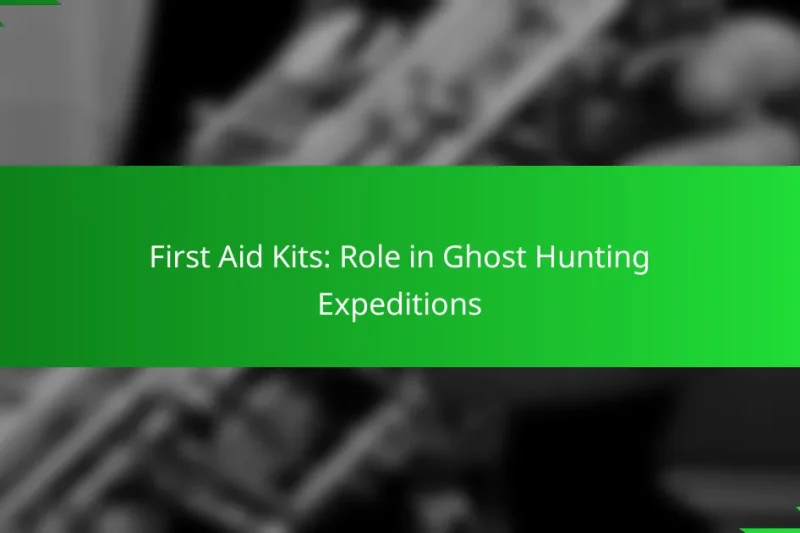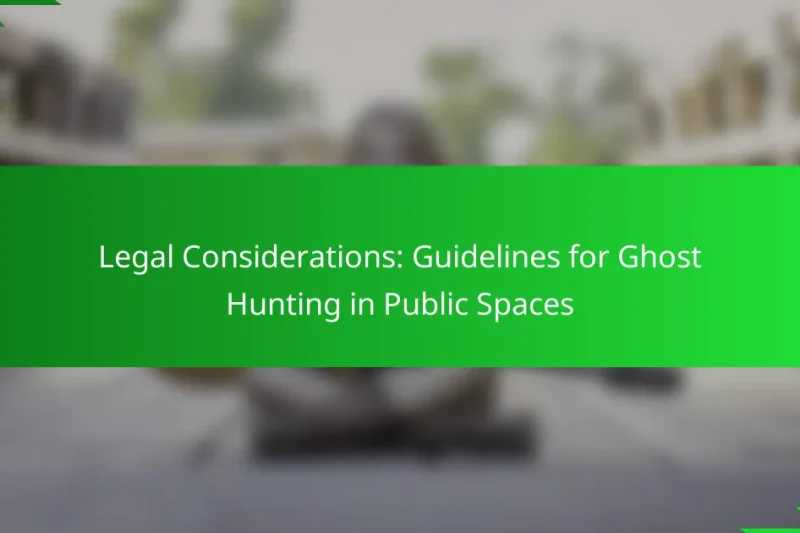Ghost hunters face unique challenges that require careful planning and strategic approaches to ensure safety during … Handling Dangerous Situations: Strategies for Ghost HuntersRead more
Ghost Hunting Equipment: Safety and Best Practices
Ghost hunting can be an exciting adventure, but it’s essential to equip yourself with the right tools and prioritize safety. Essential equipment such as EMF meters, digital voice recorders, and infrared cameras can help detect paranormal activity, while adhering to best practices ensures a respectful and thorough investigation. By preparing adequately and taking necessary precautions, you can enhance your ghost hunting experience while keeping yourself and your team safe.
First Aid Kits: Role in Ghost Hunting Expeditions
First aid kits are essential for ensuring safety during ghost hunting expeditions, offering vital medical supplies … First Aid Kits: Role in Ghost Hunting ExpeditionsRead more
Team Communication: Importance During Paranormal Investigations
Team communication is vital during paranormal investigations, as it enhances both the effectiveness and safety of … Team Communication: Importance During Paranormal InvestigationsRead more
Ghost Hunting Preparation: Key Steps for Haunted Houses
Preparing for a ghost hunting expedition in haunted houses requires careful planning and the right tools … Ghost Hunting Preparation: Key Steps for Haunted HousesRead more
Legal Considerations: Guidelines for Ghost Hunting in Public Spaces
Engaging in ghost hunting within public spaces necessitates a thorough understanding of legal considerations, including the … Legal Considerations: Guidelines for Ghost Hunting in Public SpacesRead more
Safe Locations: Choosing Nighttime Ghost Hunt Sites
When planning a nighttime ghost hunt, selecting a safe location is crucial for an enjoyable experience. … Safe Locations: Choosing Nighttime Ghost Hunt SitesRead more
What are the best ghost hunting equipment options?
The best ghost hunting equipment includes tools designed to detect paranormal activity, such as EMF meters, digital voice recorders, infrared cameras, spirit boxes, and thermal imaging devices. Each of these tools serves a unique purpose and can enhance your ghost hunting experience.
EMF meters
EMF meters measure electromagnetic fields, which some believe can indicate the presence of spirits. These devices typically have a scale that shows the strength of the electromagnetic field, allowing users to identify unusual spikes that may suggest paranormal activity.
When using an EMF meter, avoid areas with known electrical sources, such as power lines or appliances, as these can produce false readings. Look for consistent spikes in readings over time rather than one-off anomalies to validate your findings.
Digital voice recorders
Digital voice recorders capture audio during investigations and are essential for EVP (Electronic Voice Phenomena) sessions. These devices can pick up sounds that are inaudible to the human ear, potentially revealing ghostly communications.
For best results, use a recorder with a high-quality microphone and ensure a quiet environment to minimize background noise. Always ask questions and leave pauses for responses, and review recordings thoroughly for any unexpected sounds.
Infrared cameras
Infrared cameras are used to capture images in low-light conditions, making them ideal for ghost hunting at night. These cameras can detect heat signatures, allowing users to see anomalies that may indicate the presence of spirits.
When selecting an infrared camera, consider the resolution and sensitivity to ensure clear images. Keep in mind that temperature fluctuations can affect readings, so it’s important to monitor the environment during your investigation.
Spirit boxes
Spirit boxes, or ghost boxes, are devices that scan radio frequencies to facilitate communication with spirits. They produce white noise, which some believe spirits can manipulate to form words or phrases.
To effectively use a spirit box, conduct sessions in quiet locations and ask clear, direct questions. Listen carefully to the responses, and be aware that some sounds may be coincidental or influenced by radio interference.
Thermal imaging devices
Thermal imaging devices detect heat emitted by objects, allowing users to visualize temperature differences in their surroundings. This can help identify cold spots or unusual heat signatures that may suggest paranormal activity.
When using thermal imaging, aim for areas where temperature variations are unexpected. Familiarize yourself with the device’s settings and ensure proper calibration to avoid misinterpretation of the data collected.
How to ensure safety while ghost hunting?
Ensuring safety while ghost hunting involves taking precautions to protect yourself and your team from potential hazards. This includes using appropriate gear, staying in groups, informing someone of your plans, and carrying first aid supplies.
Use protective gear
Wearing protective gear is essential for minimizing risks during ghost hunting. This includes sturdy footwear to prevent slips and falls, gloves to protect against sharp objects, and reflective clothing for visibility in low-light conditions.
Consider using a hard hat if exploring abandoned buildings, as there may be falling debris. Additionally, a flashlight or headlamp is crucial for navigating dark areas safely.
Stay in groups
Staying in groups is a fundamental safety practice in ghost hunting. It ensures that help is readily available in case of an emergency and reduces the likelihood of accidents.
Form a team of at least three to four people, as this allows for effective communication and support. Assign roles, such as a navigator and a lookout, to enhance safety and organization during the hunt.
Inform someone of your location
Always inform a trusted friend or family member of your location and planned activities before heading out ghost hunting. This ensures that someone is aware of your whereabouts in case of an emergency.
Provide details such as the specific location, expected duration, and any changes to your plans. Consider using a mobile app to share your location in real-time for added security.
Carry first aid supplies
Having first aid supplies on hand is crucial for addressing minor injuries that may occur during ghost hunting. A basic first aid kit should include band-aids, antiseptic wipes, gauze, and pain relievers.
Familiarize yourself with basic first aid procedures, such as how to treat cuts and scrapes or manage sprains. Regularly check and replenish your first aid kit to ensure it is always ready for use.
What are the best practices for ghost hunting?
The best practices for ghost hunting involve thorough preparation, respect for the environment, and careful documentation of findings. These practices ensure safety and enhance the quality of the investigation.
Research locations
Before embarking on a ghost hunting expedition, it’s essential to research the location thoroughly. This includes understanding its history, previous paranormal activities, and any local legends. Knowledge of the site can provide context and help identify areas of interest during the investigation.
Utilize online resources, local libraries, and historical societies to gather information. Engaging with local ghost hunting groups can also yield valuable insights about the location’s reputation and any specific safety concerns.
Respect the environment
Respecting the environment is crucial during ghost hunting. Always adhere to local laws and regulations, especially in protected areas or private properties. Leave no trace by avoiding littering and damaging natural or historical features.
Be mindful of wildlife and local communities. If you encounter people or animals, maintain a respectful distance and avoid disturbing them. This consideration fosters goodwill and ensures a safer experience for everyone involved.
Document findings
Documenting findings is vital for analyzing evidence and sharing experiences with others. Use notebooks, audio recordings, and video footage to capture your observations and any paranormal activity. This documentation can help validate claims and provide a basis for further research.
Organize your notes and recordings immediately after the investigation. Consider creating a digital archive to store and categorize your findings for future reference. This practice not only aids in analysis but also enhances your skills as a ghost hunter.
Use equipment properly
Using ghost hunting equipment properly is essential for obtaining reliable results. Familiarize yourself with each device’s functions and limitations before the investigation. Common tools include EMF meters, spirit boxes, and infrared cameras, each serving a specific purpose in detecting paranormal activity.
Always test your equipment before use to ensure it is functioning correctly. Follow the manufacturer’s instructions and practice using the tools in a controlled environment. This preparation minimizes errors during actual investigations and enhances the credibility of your findings.
What should you consider when selecting ghost hunting gear?
When selecting ghost hunting gear, consider factors like your budget, the compatibility of equipment, and the reputation of brands. These elements will help ensure that you invest in reliable tools that enhance your ghost hunting experience.
Budget constraints
Your budget is a crucial factor when choosing ghost hunting equipment. Prices can range from low-cost items under $50 to high-end gear exceeding $1,000. Determine how much you are willing to spend and prioritize essential tools that fit within that range.
Consider starting with basic equipment such as EMF meters and digital voice recorders, which are generally affordable. As you gain experience, you can gradually invest in more advanced tools like thermal cameras or spirit boxes.
Equipment compatibility
Compatibility among your ghost hunting gear is essential for effective investigations. Ensure that different devices can work together seamlessly, especially if you plan to use multiple tools simultaneously. For example, some EMF meters can connect to smartphones for data logging.
Check if the equipment requires specific software or apps for operation. This can affect your choice, as some brands may not be compatible with others. Always read product descriptions and reviews to confirm compatibility before making a purchase.
Brand reputation
The reputation of the brand you choose can significantly impact the quality and reliability of your ghost hunting gear. Established brands with positive reviews are often a safer bet, as they tend to produce more durable and effective equipment.
Research user feedback and expert reviews online to gauge the performance of different brands. Look for brands that offer warranties or customer support, as this can provide peace of mind regarding your investment.
How to compare ghost hunting equipment brands?
Comparing ghost hunting equipment brands involves evaluating product quality, customer satisfaction, and warranty support. Focus on reliable reviews and policies to ensure you choose equipment that meets your needs and safety standards.
Read customer reviews
Customer reviews provide insights into the performance and reliability of ghost hunting equipment. Look for reviews on reputable sites, focusing on both positive and negative feedback to gauge overall satisfaction.
Pay attention to comments regarding durability, ease of use, and effectiveness in various conditions. Aim for products with a high number of reviews, as this often indicates a more reliable assessment of the equipment.
Check warranty options
Warranties can vary significantly between ghost hunting equipment brands, so it’s essential to understand what each offers. A good warranty typically covers defects and may last from one to several years, depending on the manufacturer.
Consider brands that provide extended warranties or satisfaction guarantees, as these can indicate confidence in their products. Always read the fine print to understand what is covered and any conditions that may apply.
Evaluate return policies
Return policies are crucial when purchasing ghost hunting equipment, especially if you are trying a new brand. Look for brands that offer a reasonable return window, typically ranging from 30 to 90 days, allowing you to test the equipment thoroughly.
Ensure that the return policy is straightforward and includes details on how to return items, any restocking fees, and whether shipping costs are covered. This can save you money and hassle if the equipment does not meet your expectations.





